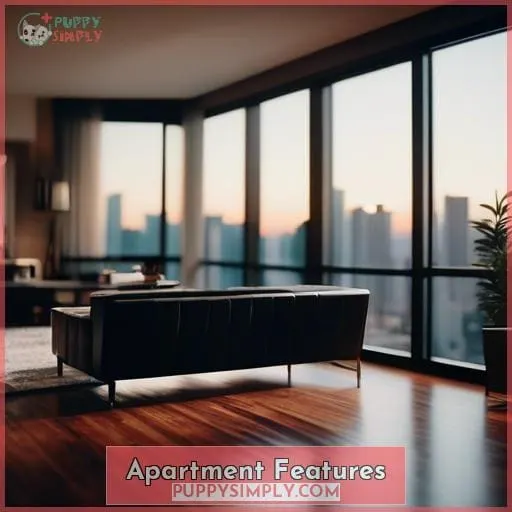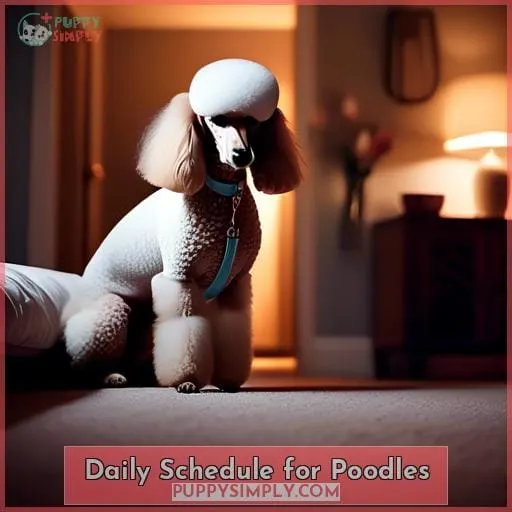This site is supported by our readers. We may earn a commission, at no cost to you, if you purchase through links.
 Perhaps you’re thinking about bringing a poodle into your life and wonder if they can adapt to apartment living.
Perhaps you’re thinking about bringing a poodle into your life and wonder if they can adapt to apartment living.
You’ll be pleased to know that poodles are indeed capable of thriving in apartments. Their adaptability and trainability make them suitable for various living situations.
This guide will explore the factors to consider when bringing a poodle into your apartment, from choosing the right size to providing adequate exercise and training.
Learn how to create a harmonious living environment for both you and your poodle.
Table Of Contents
- Key Takeaways
- Poodles in Apartments
- Suitable Sizes for Poodles
- Barking
- Energy Levels of Poodles
- Apartment Features
- Training Poodles
- Daily Schedule for Poodles
- Benefits and Drawbacks
- Other Suitable Breeds
- When to Seek Professional Help
- Frequently Asked Questions (FAQs)
- How does indoor exercise differ for poodles living in apartments compared to those living in houses?
- In addition to daily walks, what alternative forms of exercise are suitable for poodles in limited spaces?
- How can I find a reputable breeder who specializes in poodles suitable for apartment living?
- What are some common health problems that poodles living in apartments may face, and how can they be prevented?
- How can I ensure that my poodle has a well-balanced and fulfilling life despite living in an apartment?
- Conclusion
Key Takeaways
- Poodles can thrive in apartments due to their compact size, trainability, and adaptability.
- Toy and miniature poodles are ideal for apartment living, while standard poodles may find it too confining.
- Poodles may bark in apartments, but excessive barking can be managed with training and addressing the underlying causes.
- Consider a poodle’s energy level and exercise needs when choosing an apartment, and ensure it has enough space to play and run.
Poodles in Apartments
You can successfully keep poodles in apartments, regardless of their size.
Toy and miniature poodles are ideal due to their compact size, while standard poodles might require more space.
Poodles are highly adaptable and easily trained, making them suitable for apartment living.
Their intelligence and eagerness to please make them responsive to training, allowing you to establish routines and boundaries.
Additionally, poodles are generally low-shedding, reducing the amount of fur you’ll need to clean up in your apartment.
Suitable Sizes for Poodles
When it comes to poodles in apartments, size matters.
Toy and miniature poodles are best suited for apartment living, as their compact size allows them to navigate smaller spaces comfortably.
Standard poodles, on the other hand, may find apartments too confining for their larger frames and higher energy levels.
Toy Poodles
Moving on to toy poodles, these petite pooches are ideally suited for apartment living due to their compact size and adaptability.
Companionship Qualities:
Toy poodles are affectionate and loyal companions, perfect for apartment dwellers seeking a furry friend.
Grooming Needs:
While they require regular grooming, their small size makes it manageable even in limited spaces.
Exercise Requirements:
Toy poodles have moderate exercise needs, making them suitable for daily walks or indoor playtime.
Training Tips:
Toy poodles are intelligent and eager to please, making training a breeze.
Miniature Poodles
Continuing with small-sized poodles, miniature poodles, ranging from 10 to 15 inches tall and 10 to 15 pounds in weight, are also suitable for apartment living due to their compact size and adaptability.
Miniature poodles have moderate exercise needs and can thrive with daily walks or indoor playtime.
Like toy poodles, they’re intelligent and trainable, making them responsive to apartment training.
Standard Poodles
At the opposite end of the spectrum from toy and miniature poodles, you’ll find standard poodles.
Their grooming requirements are extensive, and they have high exercise needs.
Standard poodles also require ample socialization and training to curb their independent streak.
If you’re considering a standard poodle for apartment living, be prepared to invest significant time and effort into their care.
Barking
With poodles likely to vocalize in your apartment, it’s essential to consider their barking tendencies to ensure a peaceful living environment.
Fortunately, poodles are highly intelligent and responsive to training, making it possible to curb excessive barking with the right approach.
Behavior modification and training techniques can effectively teach your poodle appropriate vocalization.
Start by understanding the reasons behind their barking, as it could be due to excitement, anxiety, or boredom.
Address the underlying cause and provide alternatives to barking, such as offering toys for mental stimulation or taking them on more frequent walks to release pent-up energy.
Environmental enrichment is key to keeping your poodle occupied and content.
Provide interactive toys, puzzle feeders, and safe chew items to engage their minds and prevent boredom-induced barking.
Positive reinforcement is a powerful tool; reward your poodle with treats, praise, or playtime when they remain quiet, reinforcing good behavior and discouraging excessive barking.
Energy Levels of Poodles
You’ll also want to consider your poodle’s energy level when choosing an apartment.
Poodles have varying exercise requirements, depending on their size and age.
Toy and miniature poodles typically need less exercise than standard poodles, but all poodles need daily physical and mental stimulation to stay happy and healthy.
If you live in a small apartment, you’ll need to make sure you have enough space for your poodle to play and run around.
You’ll also need to be prepared to take your poodle for walks or runs every day.
If you don’t have enough time or energy to provide your poodle with the exercise it needs, it may be better to choose a different breed of dog.
Apartment Features
When choosing an apartment for your poodle, consider its location:
- If you can, choose a first-floor apartment or one near a yard.
- If your apartment building has an elevator, that’s a bonus—it’ll make taking your poodle for walks much easier.
Location
When selecting an apartment, you’ll want to consider its location.
Prioritize convenience and accessibility over cost and expense.
Look for amenities such as elevators and balconies that enhance your poodle’s comfort and livability.
Consider proximity to yards or parks for easy exercise and socialization.
Opt for quiet, well-maintained apartments to ensure a peaceful and healthy environment for your beloved pooch.
Elevator
If your apartment has an elevator, taking your poodle for walks becomes effortless.
No more lugging your furry friend up and down the stairs, especially if you live on a higher floor.
This convenience is a lifesaver for both you and your poodle, making walks a breeze.
With Elevator
- Effortless walks
- Convenient for all family members
- Less strain on your back and arms
- Time-saving
-
Stress-free
Without Elevator
- Lugging poodle up and down stairs
- Inconvenient, especially for elderly or disabled
- Potential health risks for poodle and owner
- Time-consuming
- Stressful
Balcony
A balcony can provide your poodle with an outdoor space to enjoy the fresh air and watch the world go by.
It’s like having a private oasis where your furry friend can relax and soak up the sun.
Plus, it’s a great way to give them some extra enrichment and stimulation.
Just be sure to poodle-proof your balcony with safety measures like a sturdy railing and a non-slip surface.
Yard or Park
You’ll want an apartment near a yard or park so your poodle can easily get outside for exercise and playtime.
A yard provides ample space for running, chasing balls, and digging.
Parks offer a change of scenery, opportunities to socialize with other dogs, and exposure to different smells and sounds.
These outdoor adventures keep your poodle physically and mentally stimulated, promoting overall well-being and happiness.
Maintenance
To ensure a comfortable and stress-free living environment for both you and your poodle, choose an apartment that’s well-maintained and quiet.
- Regular cleaning and maintenance prevent dirt and allergens from accumulating, reducing the risk of allergies and respiratory issues for your poodle.
- Proper maintenance ensures your apartment is free from drafts and leaks, creating a comfortable and healthy environment for your poodle.
- A clean and well-maintained apartment reflects your responsible pet ownership and creates a positive impression on visitors and neighbors.
- Consistent maintenance helps catch potential issues early, preventing costly repairs and ensuring your poodle’s safety.
- A well-maintained apartment provides a sense of stability and control, contributing to your poodle’s overall well-being.
Training Poodles
]
Desensitization
Often, desensitizing your poodle to different sounds can help reduce barking.
Start by exposing your poodle to low-level noises, like a ticking clock or a quiet TV, and gradually increase the volume over time.
Create a positive association by rewarding your poodle with treats or praise when it remains calm.
This sensory exposure helps your poodle adapt behaviorally to its environment and manage anxiety, ultimately reducing excessive barking.
Routine
Once you’ve desensitized your poodle to different sounds, create a structured routine for potty breaks to prevent accidents.
Plan regular walks and outdoor time to fulfill their exercise needs and avoid destructive behaviors.
Utilize indoor exercises, interactive toys, and enrichment activities to keep your poodle mentally stimulated and engaged in a limited space.
Indoor Exercises
Since you have limited space in an apartment, you can keep your poodle active with indoor exercises:
- Fetch
- Hide-and-seek
- Interactive puzzle toys
Design obstacle courses using household items for stimulating training challenges.
Engage your poodle’s mind with enrichment activities:
- Snuffle mats
- Treat-dispensing toys
Interactive games and creative play not only provide exercise but also strengthen your bond and mental connection.
Mental Stimulation
In addition to indoor exercises, mental stimulation is vital for your poodle’s well-being in an apartment.
Engage your poodle’s sharp mind with interactive toys, enrichment activities, and cognitive challenges.
Puzzle games and playful exercises not only entertain but also stimulate their intellect, preventing boredom and destructive behaviors.
Unleash your poodle’s inner genius and strengthen your bond through these engaging mental adventures.
Daily Schedule for Poodles
Let’s talk about the daily schedule you’ll need to keep your poodle happy and healthy in your apartment.
It’s all about routine:
- Morning walks
- Midday playtime or a dog walker
- Afternoon mental stimulation
- An extended evening exercise session
Morning
Start your day by taking your poodle for a walk and feeding it a nutritious breakfast.
This routine establishes a healthy morning rhythm for both of you.
Exercise strategies like fetch or brisk walks keep your poodle active and mentally stimulated.
Feeding patterns should be consistent, with high-quality food and controlled portions.
Grooming tips include brushing your poodle’s coat to prevent mats and tangles.
Behavioral training in the morning sets the tone for the day, reinforcing good habits and commands.
Midday
Taking your poodle for a midday walk or hiring a dog walker will allow it to stretch its legs and relieve itself.
This midday routine provides an opportunity for your canine companion to:
- Explore the outdoors
- Engage in some exercise
- Fulfill its natural instincts
Consider hiring a dog walker if you’re unable to take your poodle out during the day; this service ensures your furry friend gets the exercise and stimulation it needs to stay healthy and happy.
Afternoon
In the afternoon, give your poodle a Kong treat to keep it occupied and mentally stimulated.
This interactive toy will challenge your poodle’s mind and provide a sense of accomplishment.
You can also brush your poodle’s coat to remove loose hair and prevent mats.
Regular grooming helps keep your poodle’s coat healthy and looking its best.
Evening
- In the evening, you’ll engage in the longest exercise session of the day with your poodle. This could involve a brisk walk, a game of fetch in the park, or an agility course in your living room.
After the exercise, establish a calming nighttime routine. Brush your poodle’s coat, feed them a balanced meal, and provide fresh water.
Finish the day by cuddling on the couch or reading a bedtime story to your furry friend.
Benefits and Drawbacks
Before committing to a poodle in an apartment, you must consider the pros and cons carefully.
Poodles are highly adaptable and can thrive in apartments.
However, you’ll need to factor in their:
- Exercise requirements
- Barking tendencies
- Size
- Potential for separation anxiety
Benefits
For apartment dwellers, poodles offer companionship, low maintenance, and adaptability in addition to their intelligence and loyalty.
Their exercise needs can be met with daily walks and indoor activities, and their coats require minimal grooming.
Behavioral training can curb barking and ensure harmony with neighbors.
Poodles adore apartment amenities like elevators and balconies, and nearby yards or parks provide opportunities for outdoor activities.
Overall, poodles’ health and well-being thrive in apartments with attentive owners.
Drawbacks
Living with a poodle in an apartment can be challenging, requiring patience and perseverance to overcome these drawbacks:
- Noise concerns for neighbors due to barking.
- Space limitations for running and playing.
- The need for behavioral adjustments to adapt to apartment living.
As a responsible owner, you’ll need to commit to providing:
- Ample exercise.
- Training.
- Mental stimulation.
To ensure your poodle’s well-being in an apartment setting.
Other Suitable Breeds
In addition to poodles, there are other breeds that thrive in apartments.
Bichon poodles and springerdoodles are two such breeds.
They’re known for their small size, low energy levels, and friendly nature, making them ideal companions for apartment living.
Bichon Poodle
Ever heard of the Bichon Poodle, a friendly and affectionate dog breed that might thrive in your apartment?
They’re a mix of the cheerful Bichon Frise and the intelligent Poodle, carrying a history of performing in circuses and entertaining historical nobility.
These hybrids come in a variety of coat colors and are relatively healthy, although certain health considerations should be kept in mind.
Springerdoodle
Springerdoodles, another hypoallergenic breed, can make great apartment companions.
With their friendly and outgoing personality, they’re excellent family pets.
Regular brushing and ample exercise keep their curly or wavy coats healthy.
Springerdoodles thrive on socialization, so ensure they interact with other dogs and people.
Keep an eye on their health, as they’re prone to hip dysplasia, eye problems, and ear infections.
When to Seek Professional Help
If you’re considering adopting a poodle for apartment living, it’s important to know when to seek professional help from a trainer or behaviorist to address any behavioral issues.
Don’t hesitate to seek professional help if you’re struggling with training challenges or behavioral concerns.
A professional can assess your poodle’s behavior, identify the root cause of the issue, and develop a customized training plan to help you address it.
This can be especially helpful for poodles with anxiety issues or other complex behavioral problems.
Professional assistance can provide you with the tools and techniques you need to successfully train your poodle and create a harmonious living environment.
Don’t let behavioral issues stand in the way of your poodle’s happiness and your peaceful apartment living.
Frequently Asked Questions (FAQs)
How does indoor exercise differ for poodles living in apartments compared to those living in houses?
In an apartment, indoor exercise for your poodle involves creative space utilization.
Engage in lively indoor games and utilize interactive toys to stimulate their mind and body, ensuring their well-being despite limited space.
In addition to daily walks, what alternative forms of exercise are suitable for poodles in limited spaces?
Engage your poodle’s mind with interactive toys like puzzle feeders or snuffle mats.
Play indoor games like fetch or hide-and-seek to keep them active and entertained within the limited space of your apartment.
How can I find a reputable breeder who specializes in poodles suitable for apartment living?
Discover responsible breeders with a passion for matching poodle temperaments to apartment living.
Their expertise ensures a harmonious fit for your lifestyle and furry companion.
What are some common health problems that poodles living in apartments may face, and how can they be prevented?
Poodles in apartments may face joint issues due to limited space.
Regular exercise, joint supplements, and maintaining a healthy weight can help prevent these problems.
How can I ensure that my poodle has a well-balanced and fulfilling life despite living in an apartment?
Craft a fulfilling life for your poodle in an apartment:
- Prioritize daily walks, interactive play, and training sessions to keep your furry friend happy and balanced.
- Regular exercise: Daily walks and interactive play sessions are essential for your poodle’s physical and mental well-being.
- Mental stimulation: Training sessions, puzzle toys, and interactive games help keep your poodle mentally engaged and prevent boredom.
- Socialization: Arrange playdates with other dogs and take your poodle to dog parks to promote socialization and prevent loneliness.
Conclusion
Picture a poodle, its curly coat bouncing as it prances through your apartment, filling it with joy and companionship.
With careful planning and dedication, this vision can be your reality.
Embrace this journey, and you’ll discover a world of love and loyalty that only a poodle can bring.
















